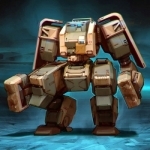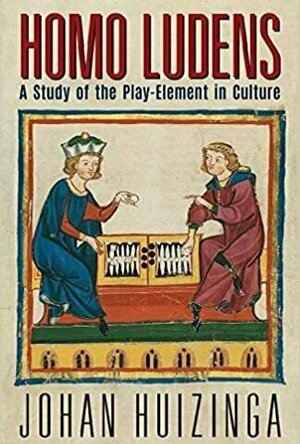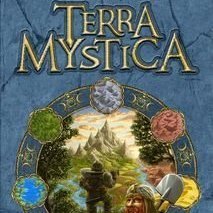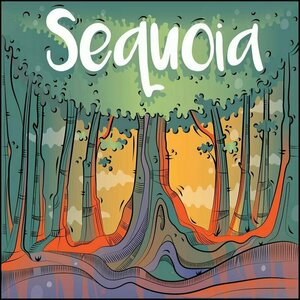Purple Phoenix Games (2266 KP) rated Sequoia in Tabletop Games
Mar 17, 2021
Sequoia is a game of dice rolling and area majority in which players are trying to grow the largest trees across different forests. To setup the game, lay out the 11 forest cards on the table within reach of all players, and randomly assign a 1st and 2nd place token to each card. Each player receives 5 dice and 20 tree tokens in their chosen color. The game is ready to begin!
On each turn, players will simultaneously roll their 5 dice – keeping the results secret from all other players! After rolling, players will create 2 pairs using 4 of their dice (one will be left out). Everyone reveals their pairs at the same time, and will place a tree token on the card that matches each of their dice pairs. For example, my pairs might be a 5 and a 2, and a 6 and a 6, so I would put a tree token on the 7 and 12 forest cards. Play continues in this manner (rolling dice, creating pairs, and placing tree tokens), until players have placed all of their tokens. Once all tokens have been placed, the game moves to the scoring phase. For each forest card, the 1st and 2nd place tokens go to the players who have the most and 2nd most tree tokens on the forest card. Once all cards have been scored, count up final points, and the player with the most points wins!
I have to start off by saying that Sequoia really surprised me. I was expecting a fast, light game, and that’s what I got. But I also got a game with a fun amount of player interaction and strategy that keeps all players engaged. You may not know what forest cards a player will choose each turn, but you can see who has already played tree tokens to each card, which can help drive your strategy. Do you want to directly compete with everyone and really pile on the tokens to win 1st place on a card? Or do you want to spread your tokens around to as many forest cards as possible, and hopefully maximize points that are otherwise being ignored by opponents? Especially since the 1st and 2nd place tokens are randomly assigned and have differing values, you really don’t know which forests will yield the highest points until the end of the game. Sequoia is a Yahtzee-esque game that allows direct player interaction, and that elevates the overall gameplay for me.
Let’s talk about components for a minute. These components are great. The forest cards are a nice thick card stock. The tree tokens and 1st/2nd place tokens are all good chunky bits that will definitely hold up over time. And the dice are nice little d6’s that are easy to read and fun to manipulate. The color matching with the dice and tree tokens is also really nice, and I appreciate that uniformity for each player color. All in all, a high quality production for such a small game.
If you ask me, I think Sequoia is a perfect filler game. It is super fast to teach and play, the setup/cleanup takes literally seconds, and it provides an engaging and fun gameplay. Beyond being a filler game, it is a great small standalone game as well. Want something fast to play while the oven is pre-heating for dinner? Pull out Sequoia! I also love that it is simple enough for younger players to understand – it is a numbers game, but you can also visually see what your opponents are working towards, and that lends itself to a good amount of player interaction. Definitely a game that I can see getting a decent amount of table time in my group! Purple Phoenix Games gives this one a sky-rocketing 8 / 12. Check it out, you might be surprised!
Charles Burbridge (13 KP) rated Ready Player One (2018) in Movies
Mar 29, 2018
The vast majority of the film is animated, which is obvious given the subject matter. The animation, however, doesn't allow the actors to deliver nuanced performances. Everything in the film is turned up to 11. There's no breaks, no subtle moments. It's full throttle, pedal to the metal, all the way through.
Now, there are some very cute character bits that are blown away by the bombast, not the least of which is the film's villain uses a Superman avatar in the Oasis, and I'm pretty sure it's the Injustice Superman, which is fitting. Yes, we've all seen the Iron Giant in the previews, as well as the cars in the race sequence.
The most surprising inclusion in the movie, the best filmed and the most impressive story-wise, is the sequence involving the retrieval of the second key. It's pitch perfect and the film should have done more like that and less Where's Waldo. Speaking of, I didn't see Waldo, but I'm sure he's in the film.
Spielberg did as Spielberg does when he wants to make enough money to finance another serious film. He made a popcorn flick. Ready Player One should please audiences and in a year without Marvel's juggernaut would have been the geek culture film of the season.
Instead, it's playing second fiddle to Black Panther, Infinity War, and, to me, Incredibles 2. Still, it's great fun and as long as you're part of geek culture, you'll enjoy it. And then tear it to pieces on the Internet because that's what we do.
Leanne Crabtree (480 KP) rated I Hate You in Books
Jan 9, 2020
This has been borrowed from the Kindle Unlimited Library.
This starts with Charisma - Charm, to her friends - coming back to college after break and dreading seeing the guy who dumped her rather publicly. He just happens to be a football player and one of the most popular guys at school so everyone knows what happens, which Charm finds hard to deal with. The only issue is neither of them are happy about what went down. Charm thought things were going well, despite the rules she set down, while Blaze ended it believing that he'd end it before Charm did. As they spend several classes together it's hard for them to continue to fight the attraction between them and neither really wants to try anymore.
This actually pulled at my heart strings more than I thought it would. At the beginning I was very much Team Charm. The dumping had come out of nowhere and I felt sorry for her with it being done so publicly and out of the blue. But the more I read, the more I got in Blaze's head, the more I began to understand his thinking. He had issues due to his childhood.
I'll admit that I wanted to bang the characters heads together a few times to try and knock some sense into them. They annoyed me in how stubborn they were being. Both wanted it to be something more but they still refused to let the other one in. GAH!
Nevertheless, I did really enjoy this and would love to read more of Blaze's football player friends, mainly Dillon with his charm and love of the ladies just to see who would win his heart.

Free Audiobooks Pro- 4,727 audiobooks to go.
Book and Education
App
Ah, to describe an app in two words... Free Audiobooks is just that- Free Audiobooks! This is the...

Warzone: Clash of Generals
Games and Stickers
App
When city states fight each other over precious resources, they need war heroes to lead their armies...

AudioBook - Free Audio Books Player and Streamer
Book and Music
App
- No Cost Money to use, No Subscription, No buy, All are Free. - TOP 100 DAILY DOWNLOADS IN BOOK...

Space Explorers
Tabletop Game
The conquest of space was one of the greatest achievements of the 20th century. In 1957, the first...

Homo Ludens
Book
In Homo Ludens, Johan Huizinga defines play as the central activity in flourishing societies. He...

Terra Mystica
Tabletop Game
In the land of Terra Mystica dwell 14 different peoples in seven landscapes, and each group is bound...
Worker Placement Gaia Project



